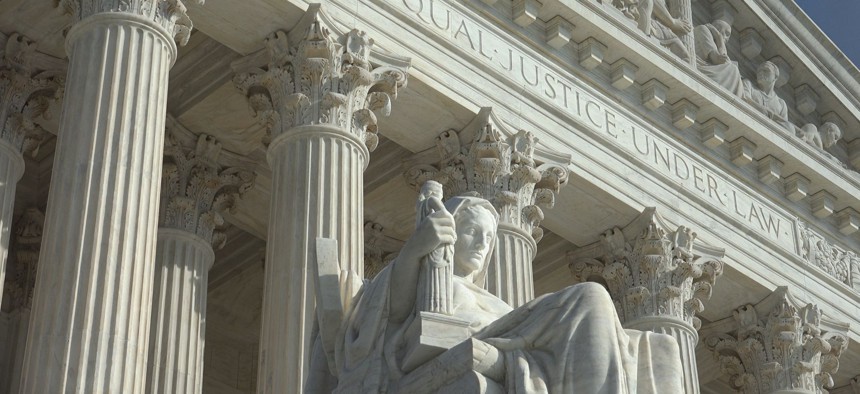More Judicial Scrutiny for Police Use of Civil Forfeitures

Shutterstock
Supreme Court Justice Clarence Thomas recently reiterated his wariness of the controversial police tactic. And a new Justice Department report seems to support his concern.
The U.S. Supreme Court receives thousands of appeals from the nation’s lower courts each year. It declines to hear almost all of them. But for Justice Clarence Thomas, one of those rejected cases earlier this month gave him the chance to challenge a widely criticized police practice: civil forfeiture.
Leonard v. Texas reached the Court after Lisa Leonard sought to overturn Texas’s seizure of roughly $200,000 in cash from a safe in her son’s car. In 2013, Liberty County police officers pulled him and his girlfriend over along what the state described as a “known drug corridor,” a law-enforcement term that can be applied to most major interstate highways. Officers seized the money and argued in local courts that the state could keep it, alleging it was likely the profits from drug sales.
Leonard, an IRS officer, said the cash was hers, denied it was related to any drug sales, and told the courts it constituted the proceeds from the recent sale of a house she’d owned in Pennsylvania. A bill of sale for the property had been found alongside the cash in the safe. Leonard testified that she started storing her money in safes after the stock market crashed in 2008, and that her son was bringing the money to Texas so she could buy him and his girlfriend a house there. The Texas courts sided with police, who only had to prove that a “preponderance of the evidence” showed the money was tied to drug activity.
Leonard asked the Supreme Court to overturn their decisions on due-process grounds. Because Leonard hadn’t raised that claim in the state courts during her initial appeal, Thomas agreed with his colleagues’ decision to decline review of it at their stage of the legal process. But he also sent a clear signal that he’d like to revisit the issue in the future. “Whether this Court’s treatment of the broad modern forfeiture practice can be justified by the narrow historical one is certainly worthy of consideration in greater detail,” he concluded.
Thomas isn’t the only one to question civil forfeiture in recent years. The practice allows law-enforcement agencies to seize cash, assets, and property from people suspected of criminal activity. While forms of the practice have existed since the country’s founding, a history Thomas himself acknowledged, state and federal agencies dramatically expanded its usage in the last 30 years during the war on drugs. That’s come with lucrative benefits for the agencies conducting the seizures, since many of them are able to keep the proceeds of what they take.
“This system—where police can seize property with limited judicial oversight and retain it for their own use—has led to egregious and well-chronicled abuses,” Thomas wrote in his statement. He cited a New Yorker article on a small Texas town where police and prosecutors collaborate to seize cash and goods from out-of-town motorists passing through, then split the proceeds between themselves. “These forfeiture operations frequently target the poor and other groups least able to defend their interests in forfeiture proceedings,” he noted.
Law-enforcement agencies often defend forfeiture as a valuable tool when tackling drug cartels and white-collar criminals. But forfeiture’s critics often echo Thomas’s concern that ordinary people, not the El Chapos and Bernie Madoffs of the world, are far more likely to be dispossessed by the process. Even among the consensus issues of liberal and conservative criminal-justice reformers, it stands out as a common villain. A report by the Heritage Foundation, one of the right’s most influential think tanks, concluded in 2015 that forfeiture laws are “in serious need of reform.” The American Civil Liberties Union has long contended that modern forfeiture violates the Constitution’s due-process protections, as Leonard argued.
Federal watchdogs have also challenged the government’s forfeiture practices. The Justice Department’s Office of the Inspector General released a report Wednesday on its investigation into the department’s forfeiture programs, which have brought in about $28 billion over the last decade. It focused on seizures by the Drug Enforcement Agency, which accounts for about 80 percent of the Justice Department’s total haul. Civil forfeiture can be profitable for the agency: The report said the DEA has seized roughly $4.15 billion in cash alone since 2007. (Other assets like cars and property weren’t counted, and they can bring in even larger sums.)
Because the federal government doesn’t keep data collections on its forfeiture programs for further study, the report instead examined a sample of 100 cases to discern any trends. It also excluded cases where agency officials didn’t find drugs or obtain a warrant to focus on encounters with lessened criminal suspicion. Of those 100 cases, 85 of them took place at transit hubs—airports, bus and train stations, and so on. That’s a large share, but not a surprising one: My colleague Conor Friedersdorf reported in 2015 on how targeting travelers is a common DEA practice.
What’s eye-opening about the Inspector General’s findings is how many of the seizures weren’t connected to any larger policing purpose. The report says the DEA only verified that 44 of the seizures had been tied to ongoing investigations or had led to new investigations, arrests, or prosecutions. In other words, more than half of the total seizures didn’t further any law-enforcement efforts. And for the large subset that took place at transit hubs, where the stops are more likely to be indiscriminate, a whopping two-thirds of seizures didn’t appear to benefit any investigations.
Unsurprisingly, the Inspector General’s office wasn’t thrilled by these findings. “When seizure and administrative forfeitures do not ultimately advance an investigation or prosecution, law enforcement creates the appearance, and risks the reality, that it is more interested in seizing and forfeiting cash than advancing an investigation or prosecution,” the report said sternly.
As a remedy, the report’s conclusion focused on policy and training issues: Inadequate guidance led to this problem, it suggested, and better guidance can fix it. But forfeiture skeptics tend to see deeper issues at work than can be solved by the crafting of intra-agency policies. Thomas, for example, raised concerns about the Supreme Court’s own precedents on the subject, which determine the legal thresholds that must be met before federal and state law-enforcement agencies can seize a person’s cash and assets.
“Partially as a result of this distinct legal regime, civil forfeiture has in recent decades become widespread and highly profitable,” he wrote, citing critical reports by the Institute of Justice, a libertarian nonprofit law firm. “And because the law-enforcement entity responsible for seizing the property often keeps it, these entities have strong incentives to pursue forfeiture.”
Thomas didn’t explicitly state earlier this month that he would vote to limit forfeiture’s scope. But he and other Supreme Court justices occasionally craft their concurrences and dissents as a sort of flare gun to catch lawyers’ attention on an issue. Justice Stephen Breyer, for example, has frequently written dissents in recent years urging his colleagues to revisit the constitutionality of the death penalty. In a concurrence two years ago, Justice Anthony Kennedy all but demanded the legal community bring a case before the Court to address solitary confinement.
Accordingly, Thomas strongly signaled that he thinks the long-standing deference to law-enforcement agencies is untenable. “In the absence of this historical practice, the Constitution presumably would require the Court to align its distinct doctrine governing civil forfeiture with its doctrines governing other forms of punitive state action and property deprivation,” he surmised. He left unsaid that such a realignment would almost certainly narrow forfeiture’s scope.
The justice’s discomfort with forfeiture has built slowly since his early tenure. In 1993, two years after he joined the Court, he noted in a partial concurrence in U.S. v. James Daniel Good Real Property that he was “disturbed by the breath of new civil-forfeiture statutes.” He and the other justices ruled in favor of the plaintiff, James Good, whose home in Hawaii had been seized by federal marshals without notice or legal proceedings almost five years after he’d completed a prison sentence for drug possession.
Three years after that decision, the Court ruled against a woman whose car was seized by Detroit police after her husband had sex with a prostitute in it without his wife’s knowledge. In his majority opinion in Bennis v. Michigan, then-Chief Justice William Rehnquist cited a “long and unbroken line of cases” in which the courts held that ignorance of one’s property’s use in a crime isn’t a defense against its seizure. The first precedent he cited, an admiralty case from 1827, dealt with the seizure of a ship engaged in privateering against the king of Spain—a slightly different set of circumstances than Tina Bennis’s plight.
Thomas joined Rehnquist’s opinion because of the Court’s past rulings, but wrote a separate concurrence that a casual observer could have mistaken for a dissent. “One unaware of the history of forfeiture laws and 200 years of this Court’s precedent regarding such laws might well assume that such a scheme is lawless—a violation of due process,” he wrote. While he ultimately deferred to the Court’s precedents, he also observed the case was “ultimately a reminder that the federal Constitution does not prohibit everything that is intensely undesirable.”
And he concluded, presciently, by warning of perils to come. “Improperly used,” Thomas observed, “forfeiture could become more like a roulette wheel employed to raise revenue from innocent but hapless owners whose property is unforeseeably misused, or a tool wielded to punish those who associate with criminals, than a component of a system of justice.”
Matt Ford is an associate editor at The Atlantic, where this article was originally published as part of the Next America: Criminal Justice project, which is supported by a grant from the John D. and Catherine T. MacArthur Foundation.
NEXT STORY: Virginia Gov. McAuliffe Blocked on Medicaid Expansion. Again.






